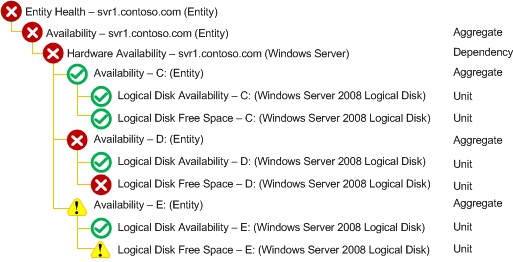Operations Manager Management Pack Authoring - Monitors and Health State
This document is part of the Operations Manager Management Pack Authoring Guide. The Microsoft System Center team has validated this procedure as of the original version. We will continue to review any changes and periodically provide validations on later revisions as they are made. Please feel free to make any corrections or additions to this procedure that you think would assist other users.
Every instance of each class in a Operations Manager service model has a health state that represents the current health of the object. This health state is set by one or more monitors targeted at the class. The health state of each monitor changes as the health of the components of the application represented by the class change.
There are three kinds of monitors as shown in the following table:
| Monitor | Description |
| Unit Monitors | Measures some aspect of the application. This might be checking a performance counter to determine the performance of the application, running a script to perform a synthetic transaction, or watch for an event that indicates an error. Classes will typically have multiple unit monitors targeted at them to test different features of the application and to monitor for different problems. |
| Dependency Monitors | Provides health rollup between different classes. This allows the health of an object to depend on the health of another kind of object that it relies on for successful operation. |
| Aggregate Monitors | Provides a combined health state for similar monitors. Unit and dependency monitors will typically be configured under a particular aggregate monitor. In addition to providing better general organization of the many different monitors targeted at a particular class, aggregate monitors provide a unique health state for different categories of the class. |
Monitors each have either two or three states. At any time, a monitor will be in one and only one its potential states. When a monitor loaded by the agent, it is initialized to a healthy state. The state will change only if the specified conditions for another state are detected.
The overall health of a particular object is determined from the health of each of its monitors. This will be a combination of monitors targeted directly at the object, monitors target at objects rolling up to the object through a dependency monitor, dependency monitors targeted at those objects, and so on. This hierarchy is illustrated in the Health Explorer of the Operations console. The policy for how health is rolled up is part of the configuration of the aggregate and dependency monitors.
The following diagram shows an example of the Health Explorer for the Windows Server class. This shows the use of the different kinds of monitors contributing to an overall health state.
